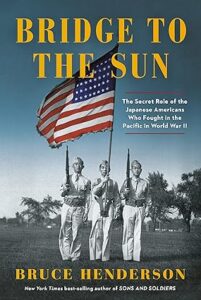U.S. MARINES DESCEND ON PELELIU
Peleliu, Palau Islands, Western Pacific Ocean • September 15, 1944
Beginning on this date in 1944 3 U.S. Marine Corps infantry regiments—the 1st, 5th, and 7th—of the 1st Marine Division landed on Japanese-held Peleliu, a 6‑mile/9.7‑km-long by 2‑mile/3.2‑km-wide speck of coral in the Pacific Ocean’s Palau Island chain. The first wave of Marines was followed less than 2 weeks later by the division’s artillery regiment, the 11th Marines, and by soldiers of the U.S. Army’s 81st Infantry Division. The initial objective of the Marines’ Operation Stalemate II was seizing Peleliu’s working airstrip, then the rest of the island all in 3 days—a cakewalk as it described in a pre-invasion briefing. Instead, Peleliu and nearby Angaur Island took 74 days and cost 2,336 Americans their lives while wounding 8,450. Enemy dead numbered 10,695; a mere 19 soldiers and 200–300 mostly foreign forced laborers survived the carnage. For the Marines, the Battle of Peleliu was the most bitter fight, and for an objective, it turned out, of questionable strategic value.
Splashing ashore on D-Day, Marine casualties approached 1,300, setting the tone for fighting on Peleliu over the next 2 months. The island’s craggy hills, steep ravines, almost perpendicular coral ridges, and rocky coral spine (Umurbrogol Mountain), christened Bloody Nose Ridge, north of the airstrip favored the defenders. Molelike, the enemy hid in fortified pillboxes and blockhouses and in formidable networks of caves, tunnels, and caverns large enough to hold entire battalions and their large-caliber mortars, heavy artillery, and ammunition. Sliding steel doors protected some hidey-holes and tunnels. The nature of the unforgiving terrain made it difficult for Marines to find cover under fire. Enemy soldiers popped out of their burrows to rake Marines with withering automatic weapons fire or else rolled grenades down slopes as men clawed up the heights. For Marines, there was almost no way to avoid the maelstrom of enemy bullets, shells, and hurled chunks of sharp coral. Some men died instantly or slowly bled to death waiting in vain for a Navy corpsman. After only a few hours of combat, Marine companies were reduced to half their original size. Six days after landing with 3,251 men, the 1st Marine Regiment, led from the front by Col. Lewis B. “Chesty” Puller, had ascended just several hundred yards/meters up Bloody Nose Ridge at a cost of nearly 2,000 casualties.
The bitter Battle of Peleliu dragged on for another 8 weeks—to November 27, 1944. The 1st Marine Division seized most of the terrain of strategic value in the first week of savage fighting. In a series of exhausting assaults, the division had taken the airfield, the commanding terrain above it, and all the island south and east of Umurbrogol Mountain. Yet the cost had been high: 3,946 casualties. The division had lost 1‑regiment, the 1st Marines, as an effective fighting unit (replaced by the Army’s 321st Infantry Regiment, 81st Infantry Division) and had severely depleted the strength of its other 2 infantry regiments—the 5th and 7th. Tragically, the earlier June–August 1944 slugfest by Marine and Army divisions on Saipan, Tinian, and Guam northeast of Peleliu, whence killer B‑29 Superfortresses lifted off for targets on the Japanese Home Islands, consigned tiny Peleliu to a footnote in the history of the Pacific War. Except, that is, for one thing: Peleliu‘s conquest was the costliest amphibious operation in U.S. history.
The Meat Grinder That Was Peleliu, September 15 to November 27, 1944
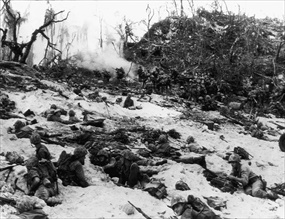 | 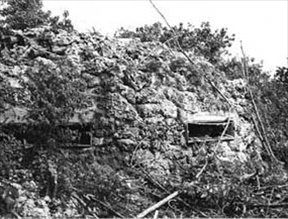 |
Left: Veterans of campaigns on Guadalcanal (August 1942–February 1943) and Cape Gloucester (December 1943–January 1944), riflemen of the 1st Marine Division dig in on a landing beach at the south end of Peleliu Island on September 15, 1944, and await orders to move forward. Aided by flamethrowers, demolition charges, bazookas, Sherman tanks, and rocket-firing (later napalm-dropping) aircraft, Marines overcame well-organized Japanese strongpoints. On D+2 3 battalions of the 5th and 1st Marine Regiments captured the island’s operational airfield. In U.S. hands the airfield could accommodate large bombers that, it was initially thought, would play a vital role in airstrikes on enemy territories and the Home Islands. (It never did.) Just 20 sq. miles/52 sq. km in size and garrisoned by over 10,000 army and naval men, the miniature island was an important piece in Japan’s Absolute Defense Zone, a last-ditch protective cordon safeguarding the Japanese mainland.
![]()
Right: A Japanese gun emplacement on Peleliu, September 1944. Marines had to blast their way past fanatical Japanese defenders in their well-concealed strongholds of reinforced concrete pillboxes, small caves to monster-size caverns (over 500 of them), and elaborate tunnel system. It was a bloodbath all around and the costliest amphibious assault in Marine Corps history. Maj. Gen. William Rupertus, aggressive commander of the 1st Marine Division, owned up to the carnage, saying: “You can’t make an omelet without breaking the eggs.” Of his 3 regiments, his battered 1st was finished as a fighting unit, relieved 10 days into the Battle of Peleliu by the Army’s 321st Infantry Regiment, 81st Infantry (“Wildcats”) Division, which had engaged the foe on Angaur Island immediately south of Peleliu. Rupertus, who had wanted the capture of Peleliu to be and remain an all-Marine affair, was finished, too, returning stateside in November 1944 to die of a heart attack the following March.
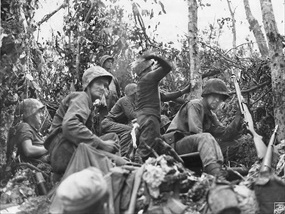 | 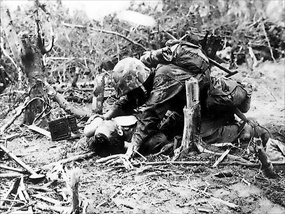 |
Left: During one of many close-quarter engagements in the dense jungle of Peleliu, a Marine hurls a Molotov cocktail (armed raised center in photo) toward crack enemy soldiers along a bitterly contested elevation nicknamed “Suicide Ridge.” George Peto, a sergeant in Chesty Puller’s 1st Marine Regiment, said after an encounter with the fire-breathing colonel, who hobbled around the battlefield on a swollen leg: “I would have followed that man to hell and that is exactly what we did on Peleliu.” That adoring sentiment wasn’t shared by many battle-weary leathernecks in Puller’s regiment; quite a few never forgave their commander for the horrific losses they sustained in Puller’s version of repeated and fruitless banzai charges on Japanese redoubts on Umurbrogol Mountain, blanketed in thick jungle, rather than opting to flank and envelop the mountain. Saying he was only following orders, Puller later admitted: “It was more or less of a massacre.”
![]()
Right: A Navy corpsman offers a wounded Marine a drink from his canteen. The 1st Marine Division lost 6,786 killed, wounded, or missing on Peleliu, over a third of their entire division; 1,111 casualties occurred on the first day. Puller’s hard-hit 1st Marine Regiment had a casualty rate of 70 percent (1,749 men). Over a 6‑day period the 1st Marines’ 1st Battalion alone suffered a 71 percent casualty rate. Marine mortarman Pfc. Eugene B. Sledge, author of the classic World War II memoir With the Old Breed: At Peleliu and Okinawa, later wrote: “We in the 5th Marines [Regiment] had many a dead or wounded friend to report about from our ranks, but the men in the 1st Marines had so many it was appalling” (p. 103). Twenty days later Sledge recorded that the ranks of his 5th Marine Regiment were just about as decimated as the 1st Marines’ had been. Beginning in mid-October, the Marines were gradually replaced by the Army’s 81st Infantry Division, which sustained 3,300 casualties during their time on the island. Of the 14 Medals of Honor awarded to Marines during World War II, 8 were awarded to Marines who fought at Peleliu.
Battle of Peleliu: 1st Marine Division Combat Footage
![]()

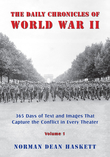 History buffs, there is good news! The Daily Chronicles of World War II is now available as an ebook for $4.99 on Amazon.com. Containing a year’s worth of dated entries from this website, the ebook brings the story of this tumultuous era to life in a compelling, authoritative, and succinct manner. Featuring inventive navigation aids, the ebook enables readers to instantly move forward or backward by month and date to different dated entries. Simple and elegant! Click
History buffs, there is good news! The Daily Chronicles of World War II is now available as an ebook for $4.99 on Amazon.com. Containing a year’s worth of dated entries from this website, the ebook brings the story of this tumultuous era to life in a compelling, authoritative, and succinct manner. Featuring inventive navigation aids, the ebook enables readers to instantly move forward or backward by month and date to different dated entries. Simple and elegant! Click 





